Hoya: description, planting, care and reproduction

Hoya is a plant from the genus Asklepiades. In nature, there are about 300 species of this tropical plant, some of them are cultivated today. These perennial vines have an amazing look, but you need to know how to care for them.

Description
Hoya, or wax ivy, is an evergreen plant. In rare cases, it looks like a bush, more often it stretches like a liana. In their natural environment, hoya grows on trees, some species grow on sheer cliffs. She uses her adventitious roots to catch on the surface. Larger species reach a height of 18 meters.
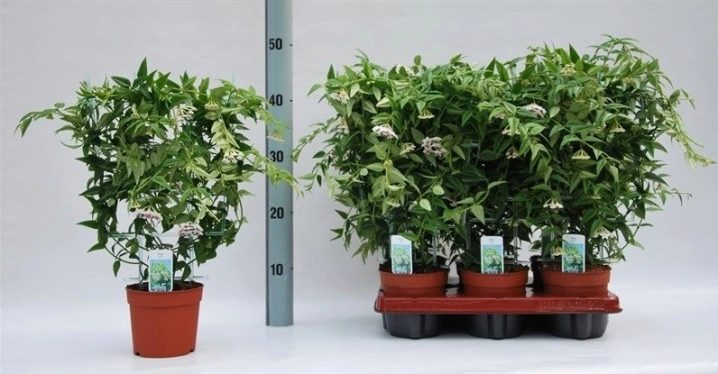
The plant has succulent leaves of a simple shape, located opposite each other along the stem. The foliage may differ depending on the variety. Their surface is:
- smooth;
- felt;
- hairy.
Some varieties have small silvery spots on the leaves.
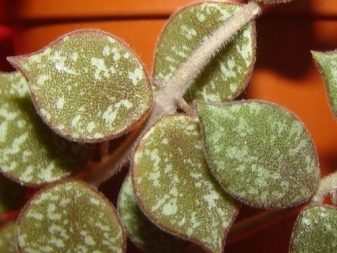

Flowers appear in umbellate clusters at the tip of peduncles (spurs), sometimes singly. In most species, these spurs are perennial and rarely fall off. Each flowering cycle increases the length of the peduncle. In larger species, over time, it can reach 27 cm. Flowers vary in size and are from 3 to 95 mm in diameter.
All flowers are shaped like pointed stars. In some species, the petals are round or spherical. It is known that in the inflorescence of Coriacea there are up to 70 inflorescences, each in diameter reaches almost 2 cm. The monochromatic Hoya pauciflora compensates for the scarcity of flowers in size. They appear at any time of the year. The surface of the petals can be smooth and shiny, sometimes matte and silky. There are varieties in which the flowers are covered with large nap. As for the color palette, it is very diverse.

The flower shape is usually star-shaped, with five thick, waxy triangular petals topped with another star-like structure, the crown. The color of the buds can be white, pink, yellow or orange. You can find plants with dark red, almost black flowers or even green. Many smell sweet, and most even produce nectar.
The main flower pollinators in the natural environment are moths, flies and ants.
Pollination is poorly understood, but a plant left outdoors in a temperate area sometimes produces seeds, indicating an interaction with local insects.

The seeds are packed in double pods. The follicles are usually light, scattered by the wind with a small tuft of silky fluff. Germination is fast, but their viability is short-lived.
One species, Hoya linearis, has leaves that resemble string beans hanging in bunches from stems. The flower is covered with fine fluffy hairs and hangs from trees in its native habitat. Some varieties have lighter or darker veins on the foliage compared to the rest. There are species with thin and translucent foliage, while others have thick and succulent foliage.
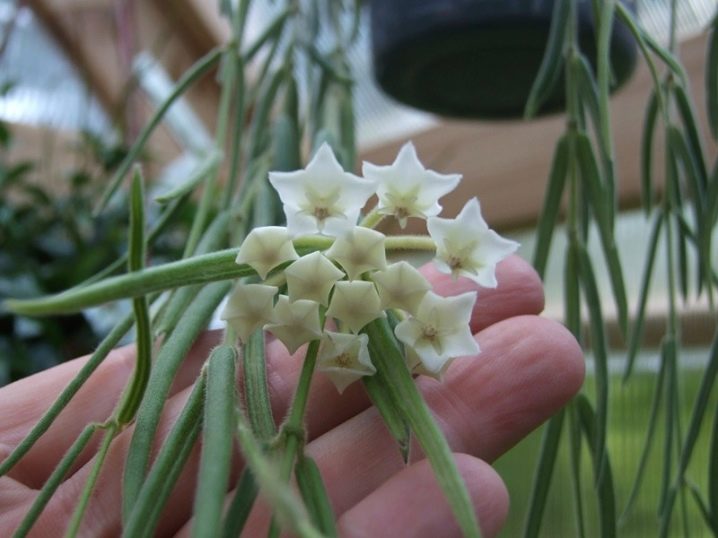
Types and varieties
Novice growers think that growing tropical vines indoors is difficult, but in reality it is not. Most varieties show vigorous growth, the plant easily climbs the wall, if provided with support, twisted around wires or trellises.
All types of hoya can be divided into three classes:
- thick leafy;
- heavy blooming;
- with unusual flowers.

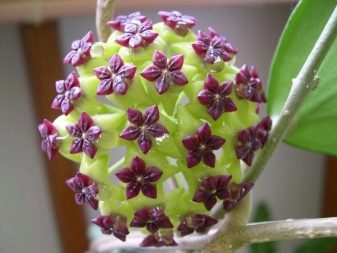
Thick leafy varieties have thick leaves unusual for this plant, similar to those possessed by succulents. They do not weave because the shoots are quite heavy and the vine cannot support their weight. One example is the pachiclada hoya, with luscious green leaves and white globular clusters of fragrant flowers.
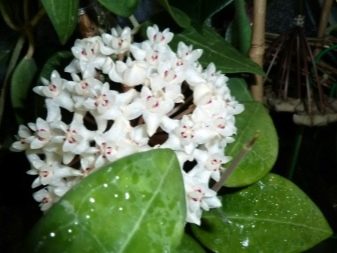
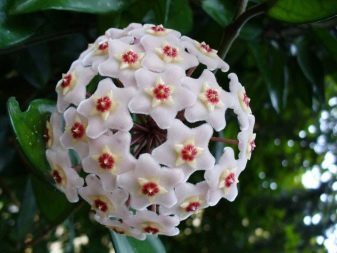
Hoya meliflois also has large, fleshy foliage. Its tiny flowers come in a variety of colors. You can find buds of pink and white with a dark purple hue center.

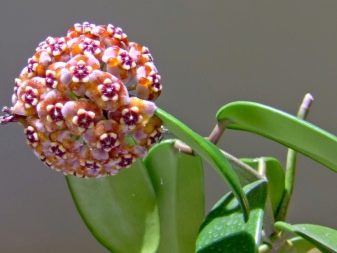
Most hoya species bloom sporadically and only when the plant is ripe. Several varieties are particularly prolific, flowering more frequently than others, and delighting in large clusters of buds. One of them - "Brookfield"... It displays large clusters of pure white fragrant flowers every time it blooms. Its young leaves are bronze in color and turn green gradually as they mature. Hoya Dipter also a representative of this species, abundant flowering is observed in the warm months.
The plant has light green oval leaves and clusters of bright yellow flowers with a pink center.
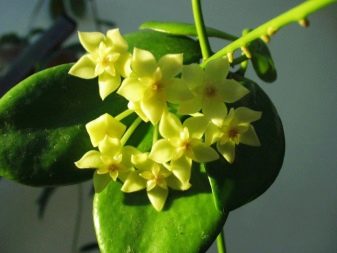
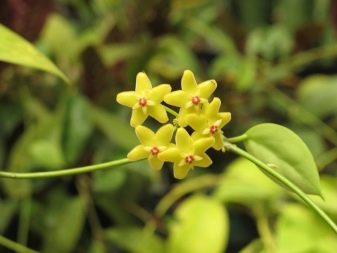
Some hoya plants have unusual flowers of impressive size and shape. Hoya imperialis - a bright representative of this species. The inflorescence usually contains about 6 buds, the plant blooms in spring. Each flower has pointed, purple-colored petals.

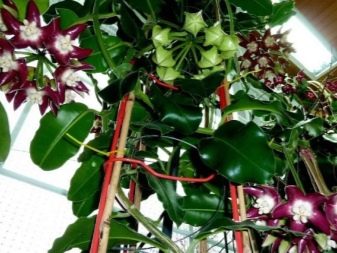
Hoya McGillivrayi will delight with pink buds. Its flowers are extremely fragrant. Hoya bilobata differs in the tiny size of reddish flowers. The variety compensates for this slight disadvantage with an abundance of flower clusters that form all year round.

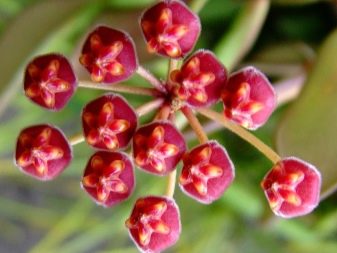
There are other varieties worth mentioning.
- "Lacunosa"... This ampelous variety is also called "Eskimo". It has foliage of a dark saturated shade, which can reach 5 cm in length and 2.5 cm in width. It differs in that its leaves are slightly curled, concave. Young branches fall down. Flowers are collected in inflorescences, each with about 20 buds. The perianth is hairy, white, with purple specks on it. Growers love the flower for its amazing aroma, which can be caught at any time of the day.
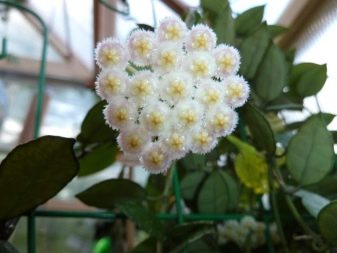
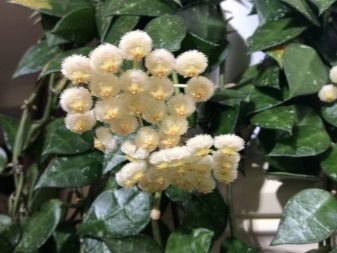
- "Matilda"... This flower is native to Australia, where it is used to abundant humidity and plenty of sun. In its natural environment, the height of the plant reaches 10 meters. In culture, he needs good support. Flowers gather in clusters and have a glossy surface. The aroma is very subtle, but well perceptible. The duration of flowering depends on the amount of light. The foliage is variegated, fleshy.
The flowers on the plant are white, with a red star in the center.

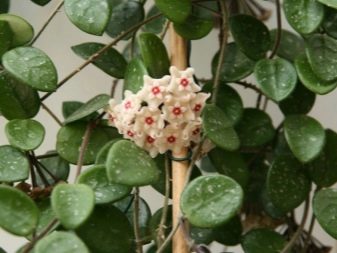
- "Multiflora". Differs in bushy form. Young shoots stand upright, leaves curl slightly. Plant breeders loved the flower for its emerald green foliage, the length of which can reach 10 cm. Veins are clearly visible on its surface. Umbrellas reach a length of 5 cm and more, each with about 22 flowers with sharp amber petals.
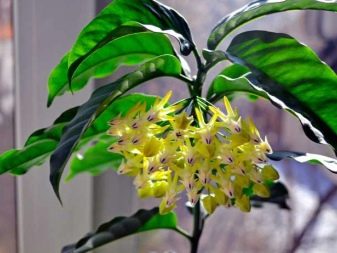
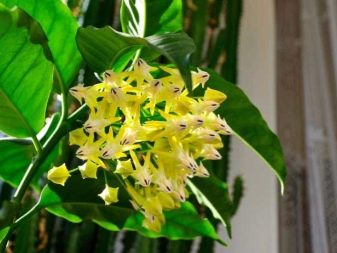
- Locke. This variety was brought from Thailand, but it also grows in Malaysia. In the center of the crown you can see protruding anthers, which distinguish the presented variety from others. The foliage has an elongated oval shape. Flowering lasts about a week. This hoya requires high humidity indoors and bright, but not direct light.
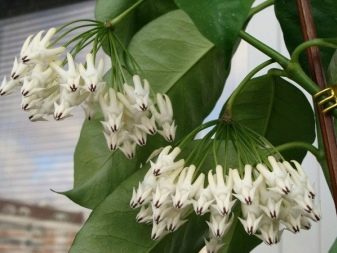
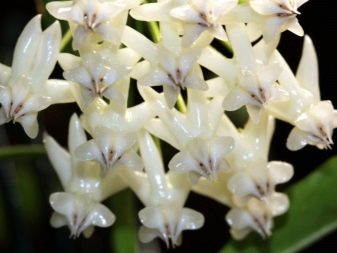
- "Tricolor". A tricolor plant that stands out for its special foliage color: it is white with a green border and attractive veins of pink. The inflorescences are large, the buds are lilac.
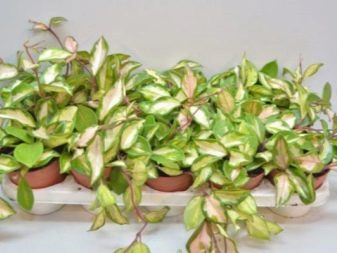
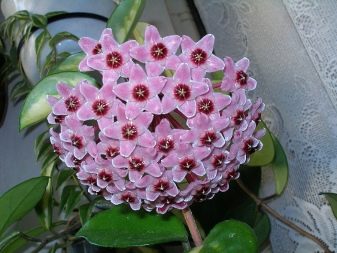
- Publicis... This is not a separate variety, but a type of hoya, which belongs to evergreens. The flower comes from the coasts of India and Australia. Of the distinctive features, it is possible to single out unpretentiousness and a large number of hybrids, among which stands out
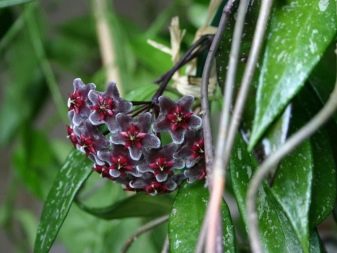
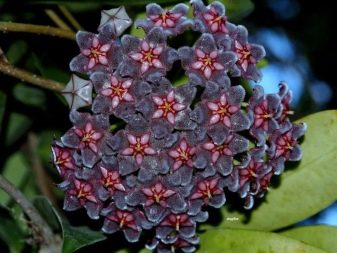
- "Silver pink" - a variety with curly voluminous flowers in two tiers. The main shade is burgundy.There are light hairs on the first petals, and in the center of the whole composition there is a five-pointed white star with a burgundy core.

- Vayeti. The presented variety is ideal for beginners, since it is easy to care for it at home. Liana can stretch up to 10 meters, which is why it is better to grow it in suspended structures. The stems wriggle slightly, roots can be seen on them. Will delight the flower with fluffy buds of red-purple color. When it blooms, it gives a lot of nectar, but it has no smell.
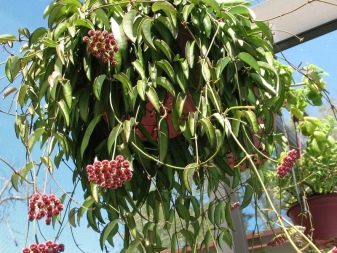
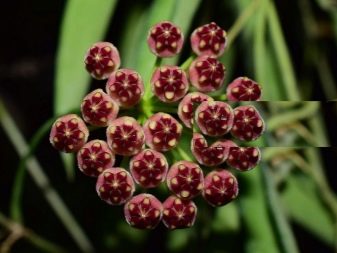
- "Australis". This name appeared due to the place where this plant was first discovered. Its foliage is glossy, attracts with its unique shine and dark green color. The shape of the foliage may differ, the veins are pronounced. It is difficult not to notice a red tint on young shoots. The diameter of the flowers is 2 cm, the corolla is white, like the crown on the petals, while the central part is painted red. On sale you can find a hybrid of this hoya, which was named "Lisa".
The flowers of the plant are large, creamy white with a burgundy center.

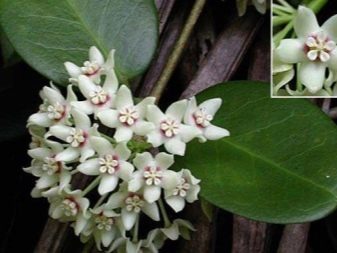
- "Gracilis". A graceful hoya that can be praised for its powerful stem. The oblong leaves show a light color with hardly noticeable spots. An adult plant shows decorative inflorescences of a bright pink hue.
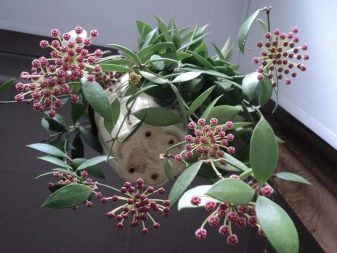
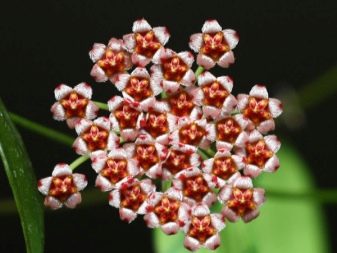
- "Obscura". This hoya is also called dark, because there are distinct veins on its foliage. The stem quickly clings to a horizontal surface, flowers appear in large clusters, but they are small. Their petals are pink and the core is yellow.
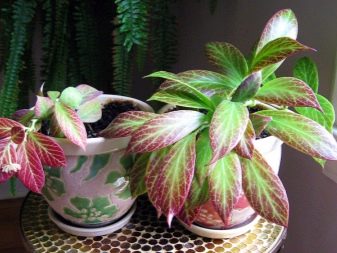

- "Obovata". Of the distinctive features of this variety, fleshy leaves can be noted, on which there are no veins. The flowers are very fluffy, they are collected in umbrellas in groups of 30 or fewer buds. The petals are pale pink, but from the inside they are darker in color.
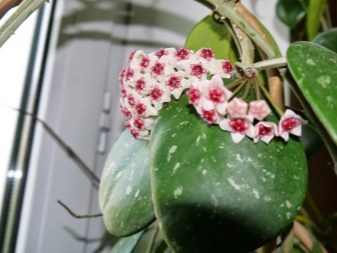
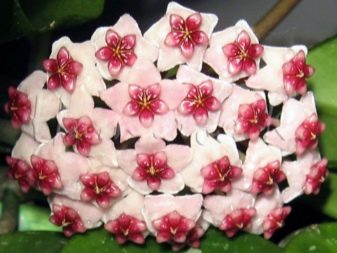
- Crimson Queen. Hoya shows a high growth rate. In a year, with proper care, it is capable of adding up to 40 cm. Flexible and rather long stems are one of its distinctive features. The leaves are located close to each other, their surface shines, the length of each leaf is up to 7 cm. Their color is striking in its decorativeness: dark green with a white edge and spots of pink hue.
The flowers are small in the shape of a star, the petals are pink, but their middle is burgundy.
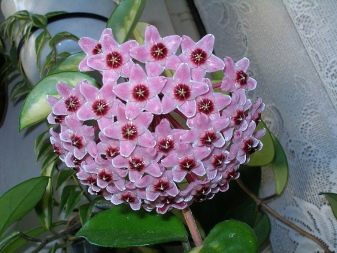

- "Compact". You can distinguish the presented variety by its small and curled leaves. The species is not common, but if you wish, you can propagate this hoya with a cuttings.
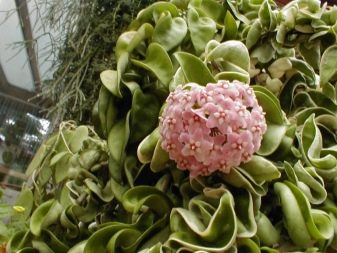

- Retuza. This variety is also called compressed hoya because it has narrow and thin leaves that form in clusters. The flowers are distinguished by their original shape, their color is white, but the middle is very bright, with a purple hue. The aroma is well perceptible, reminiscent of lemon.
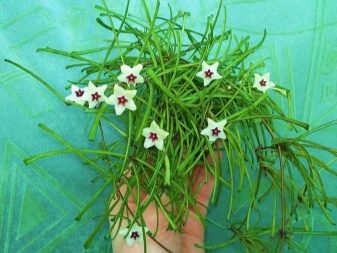
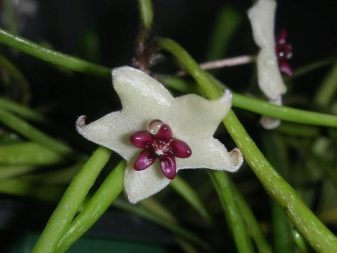
- Linearis. A rare representative of the hoya, brought from the Himalayas. The foliage is linear, light green. The maximum length of the vines is 6 meters. When its flowers bloom, you can smell the vanilla scent in the room.
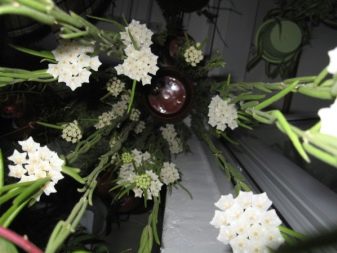
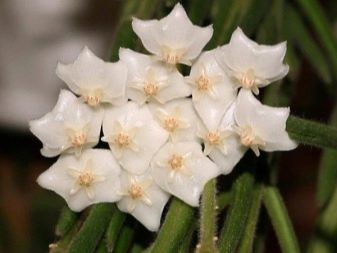
- Imperialis. The length of the vine in its natural environment is 8 meters. The foliage is oblong. Its shade is deep green, the veins are clearly visible on the surface. In all genus, this plant has the largest flowers.
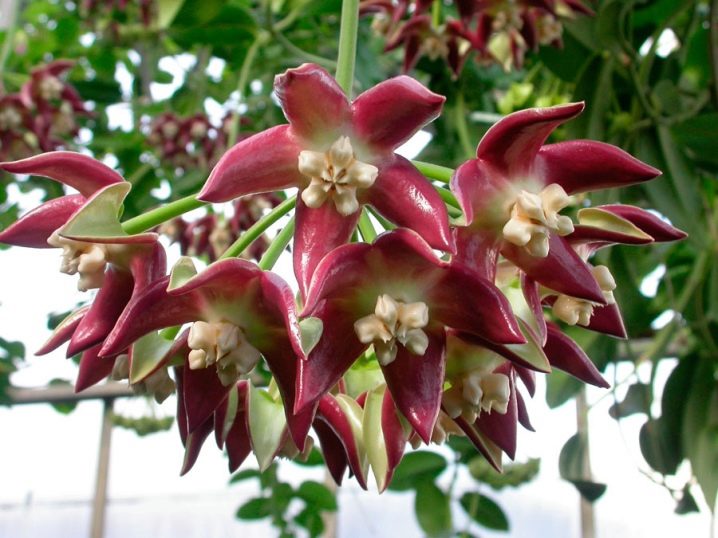
- Curtisi. This variety can be distinguished by the large number of aerial roots on the vine. The leaves are covered with spots of a silvery shade, rough, slightly sharp towards the end. The flowers are brown, gather in small dense umbrellas.
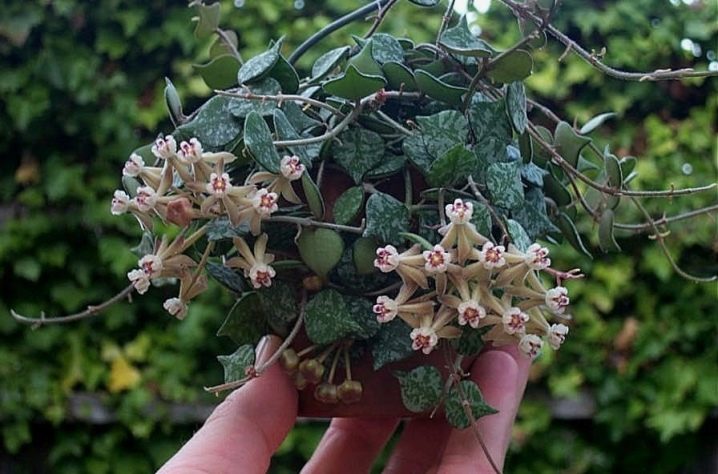
Landing
Hoya is usually grown in a hanging basket. It is not in vain that she earned herself a place of favorite among houseplants. This flower has an attractive, fleshy and shiny foliage. It blooms even with minimal maintenance in suitable conditions. Depending on the variety, the flowers can be tiny or up to a few centimeters in diameter.
The plant should be planted in well-drained soil.You can find it in any specialized store, or you can make it yourself. The ideal proportion is a mixture of peat, deciduous soil and perlite in equal parts. Before use, the soil is advised to be disinfected, for this it is placed in an oven preheated to 80 degrees and kept there for about an hour. The temperature will no longer be of any benefit, this is a misconception of novice gardeners. If you add at least a degree, then the soil will lose all its beneficial properties.
The place where the flower will stand plays an equally important role, since the hoya does not bloom in the shade. Consider installing additional artificial lighting.
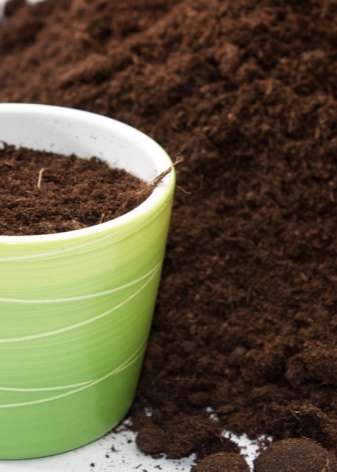
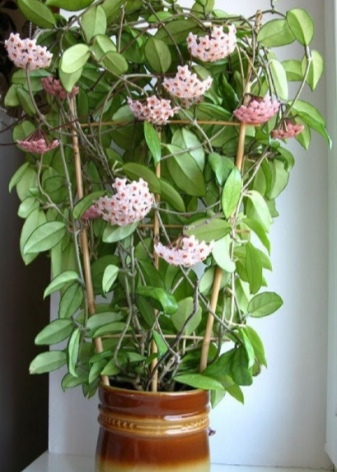
The planting process is very simple.
- Prepare the soil and container. The pot can be made of any material, as long as there are drainage holes in the bottom. It must be remembered that earthenware containers saline the soil over time, although such dishes are more porous and the soil dries out better in it.
- A stalk or young plant is placed inside the pot, in which the drainage and the first layer of the soil mixture are already laid. It must be positioned so that the root collar is at ground level and a centimeter below the edges of the pot.
- By placing the plant in the center, it is covered with the rest of the soil and lightly pressed down on the ground, removing air pockets.
- The plant will need to be watered well. and let it drain for an hour.

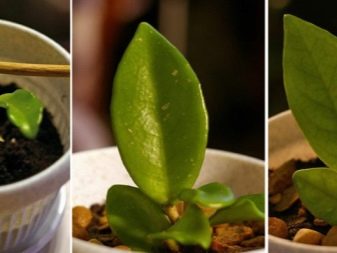
Hoya must be fertilized regularly. To do this, use balanced mixtures for indoor plants. Additional application of vitamins and minerals can induce hoya to bloom.
It is very important to give the plant in the required amount of nitrogen, phosphorus and potassium, no top dressing is applied immediately after planting. This is very important, since the flower after transplanting is under stress, its root system is poorly developed at this stage, and if you start to give fertilizers, the growth of the stem and green mass will increase, and the roots will remain at the same level.
As a result, the hoya will not be able to cope with the nutrition of its own shoots.

The best time to plant is late autumn or winter when the flower is dormant. During this period, it tolerates stress better and with the onset of a new vegetative period begins to quickly assimilate in the container.
Care rules
It is not difficult to grow hoya at home if you follow the basic rules. Like any indoor flower, she does not like negligence towards herself. In appearance, you can easily understand whether everything is going as planned at first. Sluggish flower buds are often the result of too dry or damp soil. In both cases, the grower can harm the plant, which is why experienced florists point out the importance of regular watering on a schedule. You cannot move the plant during flowering. Even a slight change in ambient temperature and humidity is immediately reflected in the appearance of the hoya.
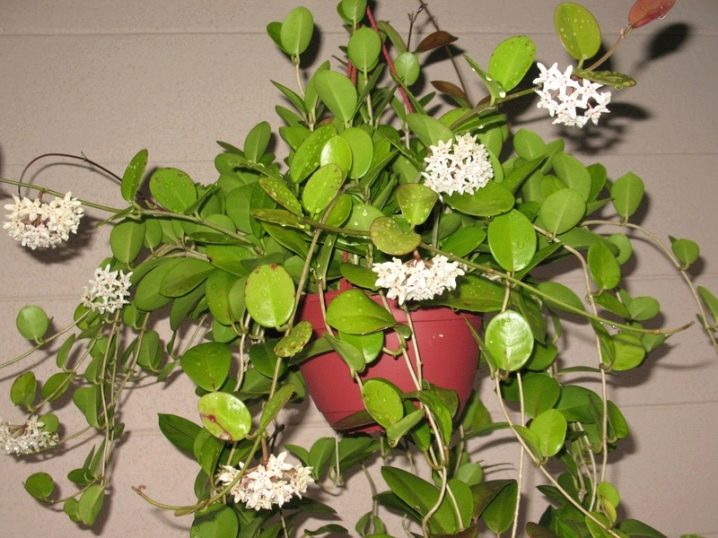
There are several rules to follow when watering:
- the higher the air temperature in the room with the plant, the more often it needs watering;
- the water should be warm, preferably one degree above room temperature;
- from time to time it is worth using distilled water - it helps to remove salts from the soil and improves the pH of the soil.
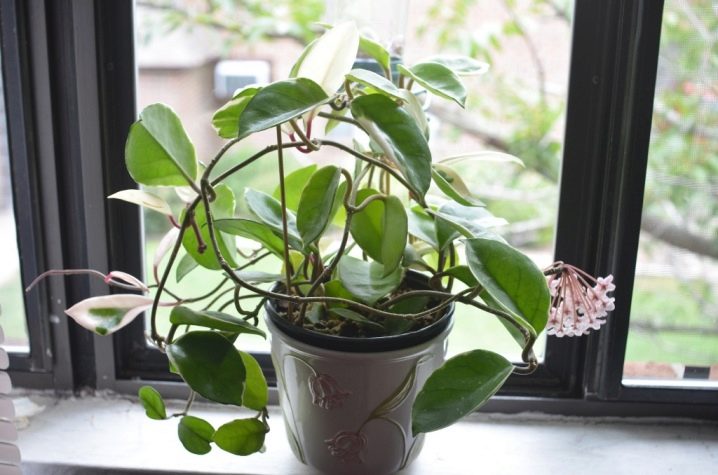
After each watering, the soil must dry well. It is very easy to check this without any special equipment. Since the soil of the hoya is rather soft and airy, the finger easily penetrates two centimeters into the depth of the pot. If it has dried up to the indicated depth, it is time to reapply the dose of water, but if the ground is still wet, it is worth waiting a couple of days.
Hoya loves water, as it grows in a natural environment in the tropics, but does not like swampy ground. This is why it is so important to use a pot with drainage holes and place a tray underneath to collect excess moisture. Cold water can slow growth or delay flowering. Often it is the cause of the appearance of fungal diseases.
It is worth using only the bottom watering; a watering can with a long and narrow spout is ideal for this. This design prevents water from entering the foliage. You can try setting the wick in the soil so that the plant can consume as much moisture as it needs here and now, while the soil remains dry.
However, once every 2 weeks, you still have to completely moisten the soil.

Besides getting enough sunlight, proper watering is the most important requirement for healthy hoya growth. Water the plant deeply until water begins to seep through the drainage holes, then allow excess water to drain.
The described plant prefers a relative humidity of 50%. Experienced growers advise using an automatic humidifier for best results. If you don't feel like spending extra money, you can place a wide container of water and pebbles on a tray and place it nearby.
Even a simple spray bottle will be a good helper in the winter, when the heating is actively working and the room becomes dry, but you need to spray water near the hoya, preventing drops from falling on the foliage.
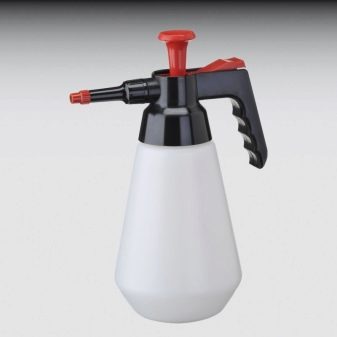
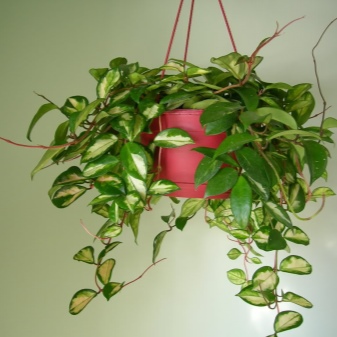
Bright indirect light all year round is what this flower loves. Direct sunlight for a short period of time is fine, but not in summer, as it can cause burns on foliage. It is better to use diffused light that passes through the curtain, or artificial - it certainly does not harm the hoya when the lamp is 20 centimeters away from the shoots.
Of course, this indoor flower will grow beautifully even without a sufficient amount of light, but then you cannot achieve flowering from it. In general, he needs 14 hours in the sun for the buds to appear. You also need to exclude the movement of the pot from place to place. Even a slight change in light level can cause the buds to dry out and fall off before opening.
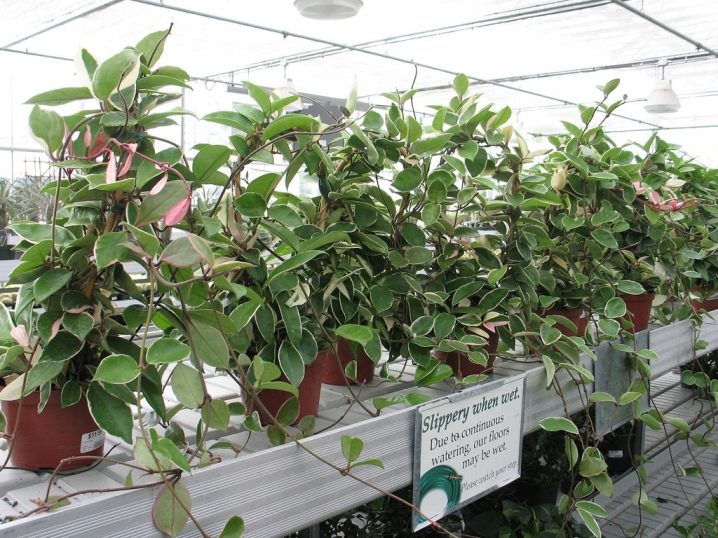
As for the air temperature, it is advisable to maintain it all year round at the level of 18-24 degrees. The minimum allowable level is 16 degrees, and then for a short period.
Fertilizers are used every two to three months in spring and summer. It is best to use water-soluble dressings in the proportion recommended on the label. They stop making them when the plant is in the dormant stage - in autumn and winter. It is imperative to observe the change in the color of the foliage in order to identify the deficiency or excess of minerals in the soil in time.
A plant with pale leaves may need to be fed more often. If the new leaves are dark green, but small, fertilize the flower less often or dilute the solution more with water.
Too much mineral concentration can burn the hoya roots.
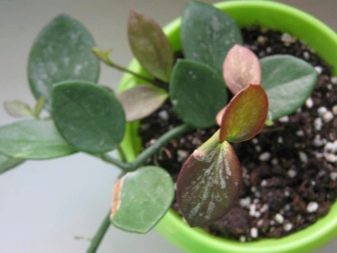
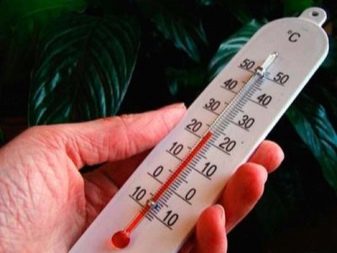
This indoor flower grows quickly. You can prune long vines if you want to keep it compact. The best time to prune is early spring, before it begins to grow. Do not prune the leafless stem or spur where there are flowers because they will form on the same shoot year after year. When cut, the stems can produce white sap.

Over time, the hoya grows out of its container and requires a transplant. This procedure is simple and easy to learn.
- You will need to clean the new container with a brushsoaked in a mixture of 10% bleach and 90% water. The new container should be at least 5 centimeters larger than the old one.
- The bottom is first filled with a drainage mass. It is best to use small pebbles or brick chips for this. Then the potting soil is poured.
- The plant should be lightly watered to make it easier to remove the roots from the old pot. Carefully turn the container to one side. Be very careful to avoid damaging the stem or peduncle.
- Taking it firmly by the base, slowly pull the plant along with the roots. When it does not give in, they pass along the edge of the ground with a knife.
- Examine the root mass of the plant for dark and offensive shootsas these are the first signs of rot. Remove any damaged appendages with a sharp knife sterilized in 10% bleach solution. Healthy roots are firm and white.
- Place the plant in the center of the new pot. Then the soil-vermiculite mixture is poured there, abundant watering is carried out and the earth is allowed to drain.
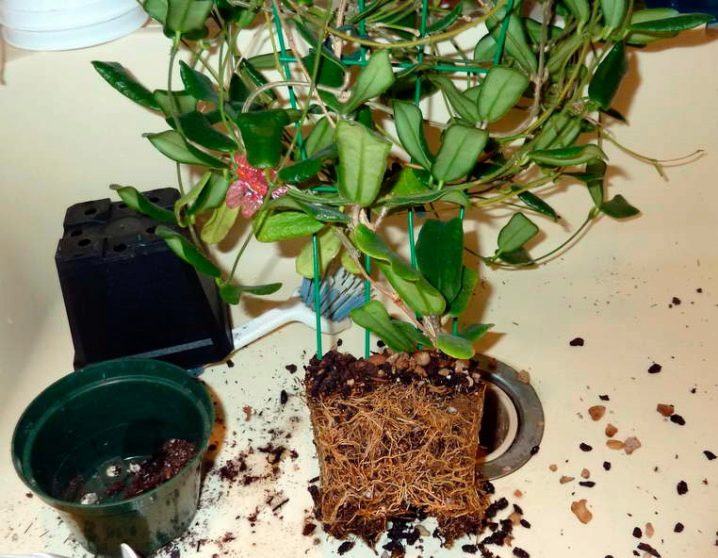
Reproduction methods
It is not at all necessary to acquire a new plant if you know how to propagate an existing hoya correctly. The easiest way is to use stem cuttingswhich can be quickly rooted in well-drained, loose soil.
Making such an environment for germination yourself is a snap. It is necessary to mix sand, perlite, peat moss. It is the latter component that allows the roots to germinate, but it can also cause problems, since such a coating prevents an even distribution of moisture. If the grower decides to use peat moss, then the medium will have to be watered two or three times before the moisture reaches the center.
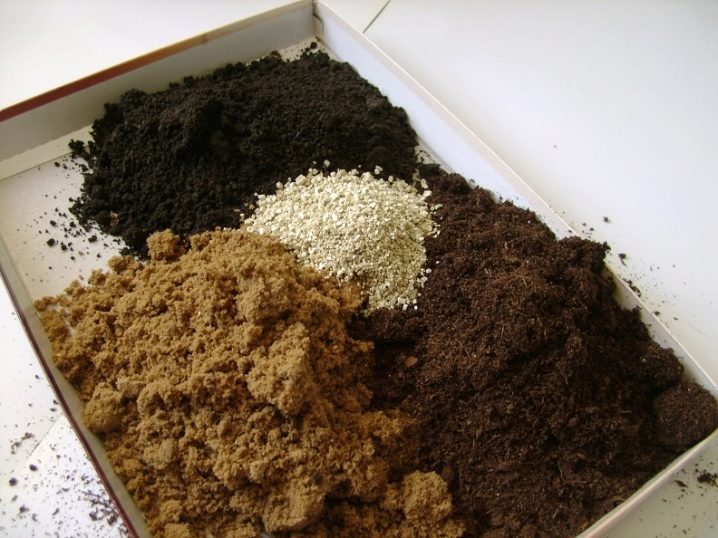
You will need to prepare enough soil to fill a 7.5 cm deep pot with drainage holes. The described flower reproduces successfully from apical cuttings collected from mature but flexible stems. Each piece should have 3 to 6 leaf nodes. The cut is made directly under the leaf assembly with a sharp, clean pruner that can be treated with alcohol, bleach, or activated carbon. Scrubbing the bottom half protects the rooting medium from contamination. Stripping is understood to mean the removal of all leaves. Flower cuttings form roots closer to or directly from leaf nodes. You can dip their end into a growth activator and only then immerse it in the prepared soil.
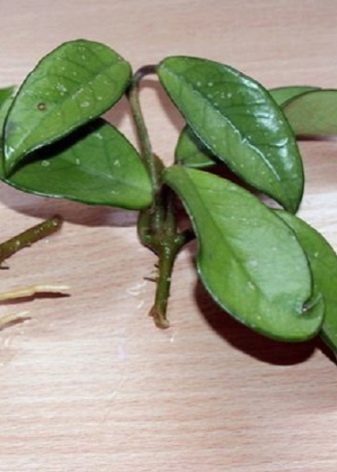

Until the root system is underdeveloped, the planted stem cannot provide itself with sufficient moisture. This is one of the reasons why it is best to cover the pot with a plastic bag. It allows you to create greenhouse conditions. From time to time, the stalk is ventilated, otherwise it may rot.
Watering is done regularly, the soil should not dry out too much. The cuttings will form roots in about 3-4 weeks. You can check this simply: you need to slightly pull on the stem, and if there is a noticeable slight resistance, then the first roots have appeared. Only after 11 months will the plant be ready for transplanting and new foliage will appear on it.
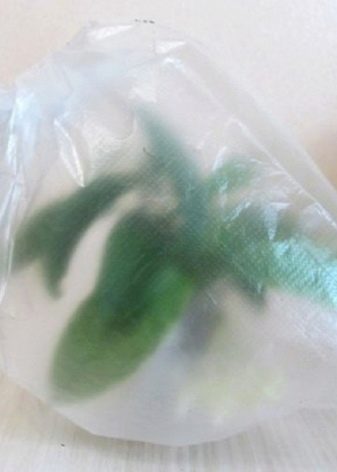
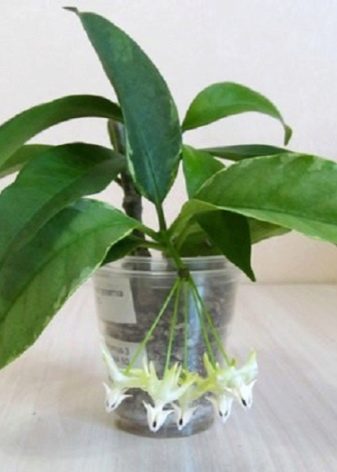
Flowering features
It is impossible to say for sure when a young plant will begin to bloom. It all depends on the variety of hoya and the conditions in which it is kept. The amount of sun plays an important role, and if it is not enough, then you should not wait for the appearance of buds. Some varieties bloom in the first year, while others do not bud for the first 3 years or more.
A lot of bright sunlight and proper watering is the best way to make your hoya bloom. After the plant has faded, in no case are the inflorescences removed, since new buds will appear in the same place, and this happens year after year.
Experienced plant breeders advise not to let the flower develop its vine too much, so it will not waste energy on maintaining them, but will use nutrients to create inflorescences.
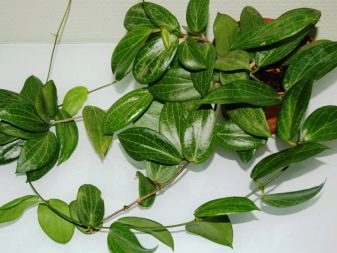
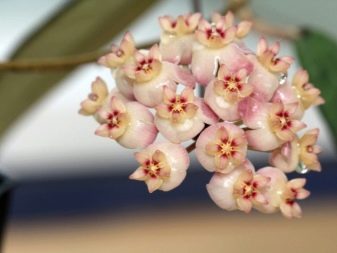
If the plant is mature but still hasn't bloomed, the following steps can be taken.
- Move the hoya container to the locationwhere there is more light, but no direct sunlight. A table 20 centimeters from a south-facing window is ideal. This rearrangement stimulates the color quite strongly.
- You can try to spray water indoors once or twice a day to maintain the required humidity level. This parameter for hoya should be at around 40-50%.
- Experienced gardeners advise using top dressing with a high phosphorus content.
- Frequent replanting should not be allowed into a larger container. This remedy is justified only if the plant suddenly stopped blooming.
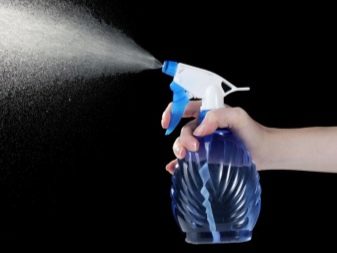

Diseases and pests
The described tropical flower is susceptible to pests and diseases. The very first symptom of their appearance is yellow leaves.
Aphids, ticks, bugs, thrips and other insects are very fond of feeding on the juice of this plant.as its foliage is juicy and fleshy. All insects capable of settling on a flower have a proboscis, it easily pierces a leaf plate and sucks sap through it.
Spider mites and aphids prefer dry air, so careful humidification can be used to prevent infection. If it so happens that insects have already appeared, then it is better to top-water the flower in the bath.
The water should be at room temperature, a shower is ideal for this.

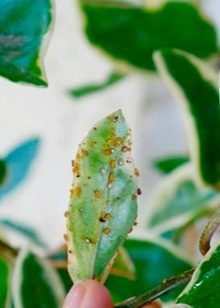
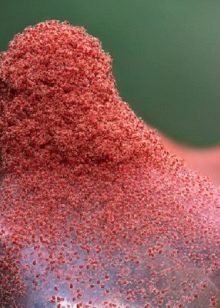
It also happens that the liana has grown decently and cannot be transported, then you can use neem oil, insecticidal soap, or just wipe the leaves and shoots with an alcohol solution. This procedure can take a lot of time, but it is very effective and allows you to cope with the problem in one go.
Thrips most often damage the roots. They are very scared off by naphthalene, so the best prevention of their attack are balls of this substance, laid on top of the ground. If an infection has already occurred, it will be necessary to transplant the plant and process its root system.
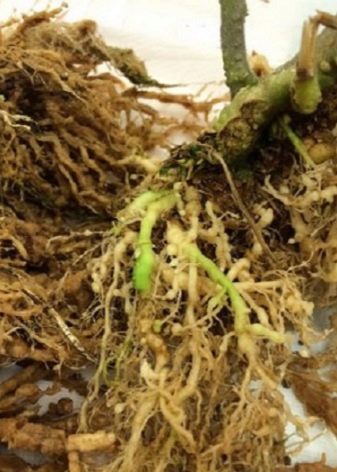
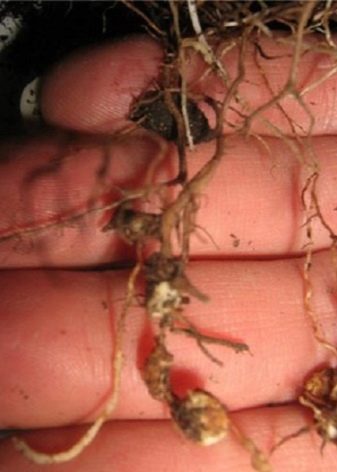
Special flies are the likely cause of black spots on the leaves of a houseplant. The larvae of this insect are small, worm-like with distinct bodies and no visible heads. They live in the soil but do not damage plants. Adult flies are black insects that rest on the tips of leaves and deposit small green or black feces on the leaves. They do not directly harm the hoye, but they can spread disease from plant to plant. To control their reproduction, it is necessary to use less fertilizers, to clean the soil with high quality from decaying plant residues.
But insects aren't the only problem. Fungal diseases are in second place in popularity, and this is not only root rot, but also late blight.
Fungal infections often affect hoya due to the use of a dirty tool, high soil moisture.

Most growers do not immediately notice stem and root rot.and then it is too late to heal the flower. One of its signs may be yellow foliage, the appearance of an unpleasant odor. When the roots are damaged, nutrients cease to flow to the plant, as well as oxygen, hence such a serious damage. It is required to immediately transplant, remove rot, cut off damaged roots and shoots, treat the bush with a fungicide.
All fungal pathogens are perfectly cured with fungicides, but as for bacterial infection, it cannot be eliminated, therefore, in most cases, the plant is simply disposed of. The only way to save the flower is to see the problem in time and quickly remove the damaged parts of the plant.
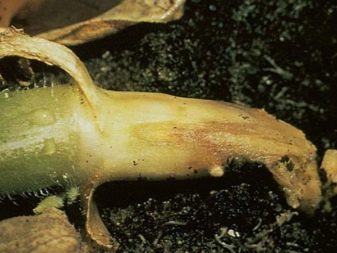
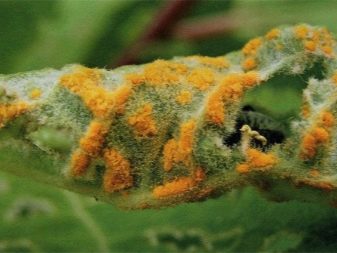
Inexperienced growers do not know that improper care is also the reason why hoya is sick. Some symptoms can strongly resemble a fungal infection, in fact, it is enough just to set up lighting, control watering and the flower will return to normal.
Poor and untimely watering, inappropriate dosage of fertilizers or their deficiency - all this affects the appearance of the flower... Do not use dry dressing on dry soil. It is required to water it first, otherwise you can simply burn the roots.
Hence the yellow leaves and brown buds that do not bloom, but fall off.
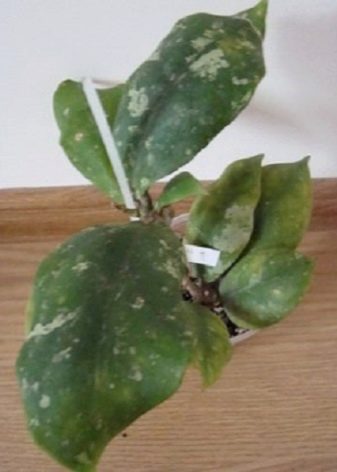
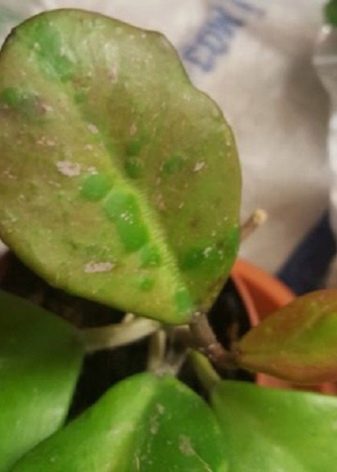
If the hoya is not getting enough nitrogen, the lower or older leaves will turn yellow or pale green. The new ones will be light green, will curl, and their size will not match the variety.If such symptoms appear, you should immediately apply top dressing, for example, an ash solution.
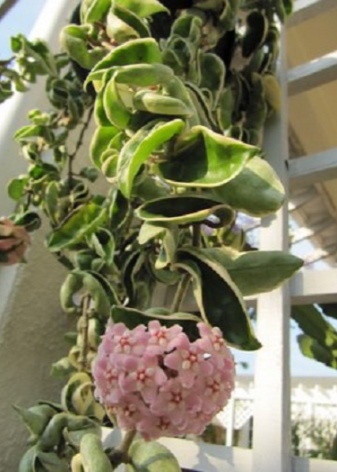

For tips on caring for hoya, see the next video.


























The comment was sent successfully.